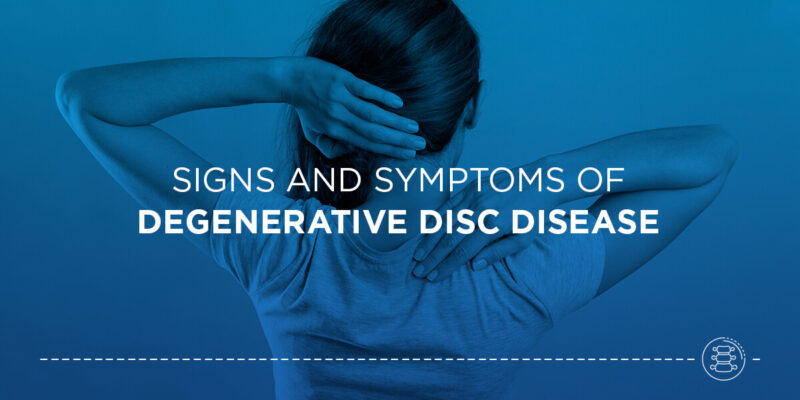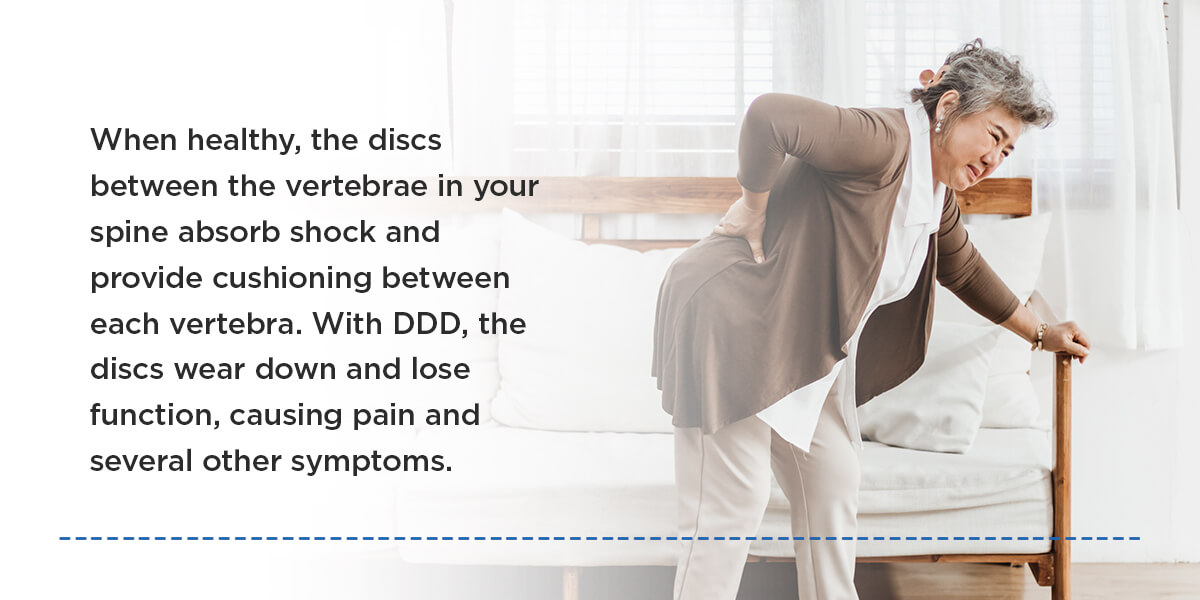

Degenerative disc disease (DDD) is a common spinal condition affecting many adults. A recent study shows that one-third of individuals between 40-59 years old experience DDD. With that prevalence, it’s crucial to consider the signs and symptoms of DDD so you can seek early treatment if you’re experiencing this condition. Continue reading to learn more about DDD, its symptoms and treatment options.

DDD is a spinal condition that occurs naturally as a person ages. That said, many people are lucky enough to avoid DDD as they age. Although it is called a disease, it is unlike most other diseases. Rather, DDD is more similar to conditions like arthritis.
When healthy, the discs between the vertebrae in your spine absorb shock and provide cushioning between each vertebra. With DDD, the discs wear down and lose function, causing pain and several other symptoms. There’s less cushioning for the vertebrae so they absorb less shock. Since discs don’t receive blood supply, they can’t regenerate once they start wearing down.
Although DDD occurs naturally with age, other reasons explain why it happens. The main causes of DDD are:
With that in mind, aging is the primary DDD risk factor. Other risk factors exist, though, including:
DDD most commonly occurs in the lumbar or cervical spine. It rarely affects the thoracic spine. If you experience DDD symptoms in your lower back, it indicates lumbar DDD. Conversely, DDD symptoms in your neck suggest cervical DDD.
The warning signs and symptoms of DDD are different than what you might expect. For example, DDD pain is often more severe for younger individuals than for patients past the age of 60. Further, severe DDD pain doesn’t necessarily indicate severe disc damage. Mild damage often produces severe pain, while severe damage sometimes produces no pain.
In that light, here are some early warning signs and common degenerative disc disease symptoms:
Diagnosis for DDD involves at least two stages, sometimes three.
During this stage, you and your doctor will review your medical history and discuss:
After gathering this information, your doctor will conduct a physical examination. The physical examination stage involves palpation and a range of motion or reflex test. “Palpation” is the medical term for using fingers and hands to examine a problem area.
As they palpate the spine, they check for abnormalities, tender spots and swelling. The reflex or range of motion test will see how much movement your spine allows. During these tests, your doctor will likely ask you to bend your spine forward, backward and to the side.
If these first two stages provide inconclusive information to diagnose or rule out DDD, your doctor may order magnetic resonance imaging (MRI). The MRI can show if other issues are contributing to the symptoms, such as:
If your doctor diagnoses you with DDD, you have several treatment options. These options vary with each patient, with surgery being a last resort. In almost all DDD cases, doctors recommend physical therapy. Physical therapy restores function and mobility, decreases pain and prevents disability through modalities, such as:
To help with pain, your doctor may also prescribe non-steroidal anti-inflammatory drugs (NSAIDs). If surgery is necessary, the main options are fusion surgery or disc replacement surgery.
Fusion surgery involves joining two vertebras. In contrast, disc replacement surgery involves replacing the damaged disc with an artificial one. Early treatment of DDD leads to the best outcomes and increases your chance of avoiding surgery.
If any degenerative disc disease symptoms resonate with you, put your mind at ease by scheduling a consultation with one of our spine specialists at New York Spine Institute. Our team of medical professionals will help determine the cause of your symptoms and provide specialized treatment solutions.